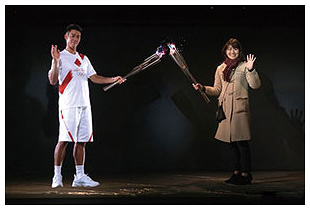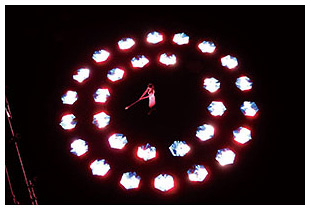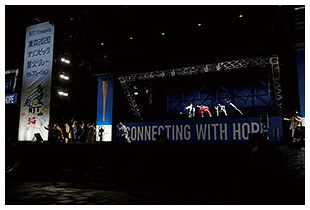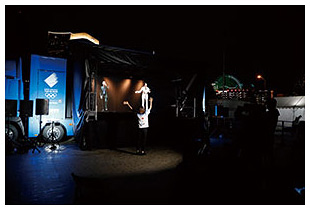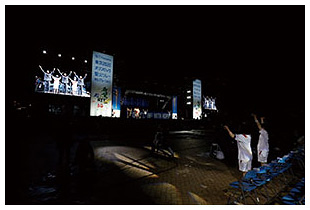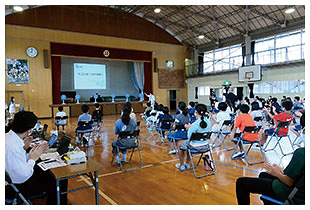 |
|
|
|
|
|
Feature Articles: Olympic and Paralympic Games Tokyo 2020 and NTT R&D—Technologies that Colored Tokyo 2020 Games Vol. 20, No. 1, pp. 53–58, Jan. 2022. https://doi.org/10.53829/ntr202201fa9 Initiatives toward a New Way of Experiencing and Supporting the Torch RelayKeywords: Olympic and Paralympic Games, Torch Relay, ultra-realistic communication technology Kirari! 1. Tokyo 2020 Olympic Torch RelayThe Tokyo 2020 Olympic Torch Relay, which started in Fukushima Prefecture on March 25, 2021, was supported by 10,515 torchbearers over 121 days through all 47 prefectures in Japan. The purpose of the Torch Relay is to embody the Olympic ideals of peace, unity, and fraternity by connecting the entire host country with the torch, which is the symbol of the Olympic Games, and build momentum for the upcoming Games throughout the country. NTT believes in the purpose of the Torch Relay and initiated various support activities to help spread this light of hope throughout Japan. We were involved in four activities: (i) supporting the torchbearers, (ii) supporting celebration events, (iii) supporting expanded versions of the celebration events, and (iv) hosting regional torch-relay events. (i) The first activity (torchbearer support) involved recruiting and recommending torchbearers and providing various types of support for the selected torchbearers and cheering them on during the relay run. (ii) The second activity (celebration events), which was held at the points where the torchbearers finished each day, involved cheering on the torchbearers from a stage and holding exhibitions such as a commemorative photography of a Torch Relay torch. (iii) The third activity (expanded celebration events) involved expanded versions of the second activity and large-scale events such as live performances and exhibitions. We originally planned to hold such events with an audience of 5000 people in Osaka on April 13 and in Yokohama on June 30. (iv) The fourth activity (NTT event) involved designating business sites as the Torch Relay route and holding events through which neighbors, students, employees working on site, and others could experience the Torch Relay together. NTT research and development (R&D) laboratories organized one such event at the NTT Yokosuka R&D Center, which invited elementary and high-school students from around the neighborhood. Due to the spread of novel coronavirus (COVID-19), the Torch Relay was postponed for one year. After the postponement, it was still affected by the pandemic in various ways. At the beginning of the Torch Relay, many torchbearers ran on public roads; however, as the pandemic worsened, more and more local governments decided to take the Torch Relay off public roads, eleven prefectures took it off public roads altogether and nine prefectures took it off certain public roads. Accordingly, most of the celebration events were restricted or even cancelled. The expanded celebration event scheduled to be held in Osaka was streamed online instead of being attended on site by the general public. The expanded celebration event scheduled to be held in Yokohama was also streamed online and closed to the general public, and only torchbearers and their families and friends were allowed to watch on site. A number of regional torch-relay events—as well as events organized by NTT—were also cancelled. Unfortunately, the festive momentum that was initially expected did not fully develop; regardless, NTT continued its support because it felt the need to use the power of communication to protect communication between people and spread the light of hope throughout Japan. 2. A new form of experiencing and supporting the Torch Relay by NTT R&DNTT R&D has been researching and developing communication technologies and experimentally applying them to various fields to explore new forms of entertainment and art that connect people and enable amplification and sharing of emotions through communication. We have been engaged in ultra-realistic stage production and live transmission of kabuki, music concerts, fashion shows, sports, and other events by using our ultra-realistic communication technology called Kirari!, spatial-image production based on moving display bots using robot- and video-communication control technology, and other art exhibitions. For the Tokyo 2020 Olympic Torch Relay, we used these communication technologies and expertise to help make the Torch Relay more exciting. Using the latest communication technologies, such as Kirari! and the communication control technology called “Swarm,” we could support the above-mentioned events. 3. Commemorative photo of the Torch Relay torchAt the celebration and the expanded celebration events, we hosted a booth at which visitors could take commemorative photos of the Torch Relay torch by using communication technology. The best user experience for visitors was to actually hold the torch in their hands, appreciate its beauty and weight, and feel as if they were torchbearers. We further enhanced that experience by applying communication technology in the following exhibits. The first was the Virtual Torch Kiss, Torch Relay Commemorative Photo Corner: Kirari! Version. In this experience, the participant was able to share a “virtual torch kiss” with the professional tennis player Kei Nishikori displayed as a holographic image (Fig. 1).
The second was the Torch Relay Commemorative Photo Corner: Optical Illusion Version. In this experience, projecting light triggered optical illusions that created a mysterious “trick space” in which the still pictures on panels appeared to move. The third was the Torch Relay Commemorative Photo Corner: Kabuki Version. This was an interactive-experience exhibit that combined NTT’s communication technologies. When participants held a kabuki mask in front of their faces for a few seconds, their faces appeared on a monitor in kabuki makeup and they could have a commemorative photo taken while holding up a torch. 4. Spatial production to support torchbearersCommunication technology was used to coordinate countless moving displays (display bots) and create a space from which to cheer on the torchbearers while the road surface was being decorated with images (Fig. 2). The magical expressions created by the multiple display bots by approaching or moving away from each other, displaying images individually or as a group, and so on gave the feeling that they were a swarm of living creatures. This spatial production was the result of joint research by NTT and Ars Electronica, a world-renowned media art research institute.
5. Stage production for celebrating the Torch RelayKirari! was used for a stage production called “GENERATIONS from EXILE TRIBE” in the expanded celebration events held in Osaka and Yokohama. We attempted to overcome and improve the circumstances that made it difficult to bring people together due to the COVID-19 pandemic through the power of communication. The first part of this production was “remote collaboration” (Fig. 3). It had become difficult for artists to get together due to the COVID-19 pandemic. Artists from different locations tried to create a group dance in tune with the song “Choo Choo TRAIN” by EXILE. Images of artists dancing separately were instantly cropped by Kirari! to create a composite image that gave the impression that the artists were dancing together in the same place.
The second part of the production was “remote live viewing” (Fig. 4). This viewing experience created the impression of the artist being teleported in front of the viewer even though the viewer could not go to the live venue due to the pandemic.
The third part of the production was “remote fan interaction” (Fig. 5). Due to the pandemic, it had become difficult for artists to interact with their fans. Therefore, we created an experience that made the fans feel like they were standing next to the artist while sharing the same space.
6. Regional torch-relay eventsWe had initially planned to invite local elementary school students to the NTT Yokosuka R&D Center to participate in the torch-relay event. As a new means of cheering during the pandemic, each student made a device for “paper-cup communication” that would let them cheer while preventing droplets spraying from their mouths when they shouted (Fig. 6). This event was cancelled because of the increase in COVID-19 cases; nevertheless, to give the students (who were looking forward to the event) memories of the Torch Relay, we went to the school and held a cheering event using paper cups, holding a torch commemorative photo shoot by the students, and presenting a technical lecture by researchers, all of which the students enjoyed.
|
|









